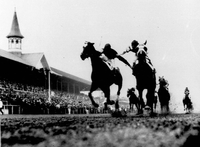| Conformation Clinic: Thoroughbred Mares Evaluate and place these 3-year-old Thoroughbred mares in your order of preference, then see how your choices compare with an expert judge's.
Basically, I look for overall balance first. A well-balanced horse will be able to perform athletically and will be a nice mover. I'll draw an imaginary line from the tail to the front of the hip, then right in front of the hip to the withers, and from the wither to the poll, and then I'll look to see how balanced those three pieces are. I'll also look for a pretty head, and I'll check to see how the neck ties in--I want to see it tie in at a good angle with the shoulder. I also want to see a nice topline and a big, round hip from adequate muscling. From there, I'll check for breed and gender characteristics. I want a mare to look like a mare; she should be pretty and shouldn't look like a gelding. I'll go on to look for any structural faults, checking to see if her legs look correct and properly aligned, and the hocks are well-angled and low-set. Click "Next" to find out how I placed these three 3-year-old Thoroughbred mares. |
|
First: Mare C
Her long sloping shoulder, coupled with pasterns at the same slope, tells me she should have a soft stride. Typically, if a horse is real straight in the pasterns, she'll be real straight in the shoulder, too, which will lead to more concussion on the joints and possibly soundness issues. She ties in really well from her neck to her shoulders to her back. The way she's standing, she looks a little higher in her hip than her withers, but that may just be the photo. She has a nice hip, and her hocks are low to ground, which'll help her with impulsion and collection, and she has a nice tail set--she'll carry herself well. She might be able to put some more muscle on, and sweating her neck might make it a little more elegant, but overall I thought she was a really attractive mare.
Second: Mare A She's a lot more balanced than the third place horse, with a really nice hip, and hocks that sit low enough to the ground for good impulsion. She should be able to work with her hind end underneath her. She's also little longer in the back than the first place horse. She may have a little bit of a splint on her right front, but unless it's accompanied by other structural problems, it's probably just cosmetic.
Third: Mare B Moving back, her hind end appears weak, and her hocks sit really high, which tells me she may lack impulsion from behind, and it'll be harder for her to collect and work off her hind end. She almost looks a little over in the knees, which could lead to soundness problems, though it might just be the way she's standing. Rob Meneely is a carded judge for the American Quarter Horse Association, American Paint Horse Association (APHA), Appaloosa Horse Club (ApHC), Palomino Horse Breeders Association, National Reining Horse Association and the National Snaffle Bit Association. His judging assignments have included Paint Horse Congress, the APHA World Show and the APHA European Championships in Australia, France, Italy, Germany and Denmark. Rob and his wife, Mary, and their clients have more than 400 ApHC world and national titles to their credit. This article originally appeared in the August 2006 issue of Horse & Rider magazine. Enter Your Horse in Conformation Clinic! To submit a photo of your horse to be evaluated in our Conformation Clinic, send us a left-side view photo of your horse (for digital phots: high-resolution, 300 dpi, in at least 3" x 5"). Make sure he's well-groomed, looking straight ahead and standing on level ground--and try to avoid distracting backgrounds. Email amanda.peterson@equinetwork.com and include your contact info and your horse's breed, age, gender and height. |
| Find this article at: http://www.equisearch.com/horses_care/health/anatomy/tbmareconformation_072606/index1.aspx |
Trackback URL : 이 글에는 트랙백을 보낼 수 없습니다
Trackback RSS : http://www.fallight.com/rss/trackback/1341
Trackback ATOM : http://www.fallight.com/atom/trackback/1341











